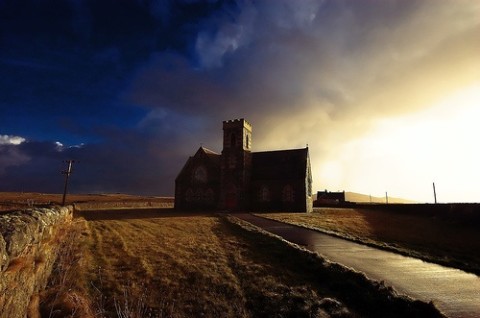The post-anxiety church
We church leaders need to stop fretting about our future and immerse ourselves in the baptismal waters that proclaim perfect love.

When I speak at denominational gatherings, pastors often ask me to say something about the future of the church. The subtext of their invitations is, “If you have any ideas for survival, let us know.”
The future of the church is a question that makes it way deep into my bones. I worry too. But the church has never looked less attractive than when it dresses in anxiety. Historically that’s when we’ve made our worst mistakes. Fear makes us desperate. We throw the little money and energy that remains into trendy programs that make no substantive change. Or worse, we become fixated on finding someone to blame for our demise. These are expressions of despair, which is where anxiety lands after it slides to the bottom.
Some righteously reassure us this is the way people have always treated prophets who took courageous stands against the injustices of their day. The mainline church is dying, they say, because society cannot handle the hard truth its preachers proclaim every Sunday.
Read our latest issue or browse back issues.
Others look longingly at evangelical congregations that appear to be growing and graft new market-driven strategies onto a centuries-old theological tradition. In some congregations the graft takes, but at considerable cost to the tradition. Eventually the historic roots wither, the tradition is lost, and all that remains is another construction driven by what the consumers want.
Still other church leaders cling to tattered 20th-century denominational bureaucracies that make it incredibly hard for the Holy Spirit to sneak in with a new idea.
Meanwhile most of the people who used to fill the pews of the mainline congregations long ago decided that the church has little relevancy to their souls, which are worn down by work, family, and a world that seems to be coming apart at the seams. They didn’t leave in a huff. They didn’t nail up 95 theses that called for reform. They wandered away and found that a Sunday morning spent with the New York Times or cheering for a child’s soccer game came closer to a sabbath than what they found in a sanctuary.
Little good comes from getting fixated on the empty pews. The mainline Protestant church has to stop fretting about its future. The anxiety takes up the air and leaves the church too lethargic to offer anything to the world. The alternative response is for the church to do what it’s always done at its best, what it did from the beginning: stop thinking about its future and sacrifice itself to its mission.
When I was working through my way through a graduate program in the history of Christianity, I became convinced that there is no rational explanation for the church’s survival over the past 2,000 years—there were many compelling political, intellectual, and social reasons for it to have gone out of business long ago. And none of those threats were ever as dangerous to the church as it was to itself. We’ve always been our own worst enemy when we fail to live out of the gospel we proclaim. But still the church perseveres.
The only possible explanation for the church’s survival is that Jesus Christ chose to use it to continue his mission of bringing the kingdom of God to earth. He can certainly work outside of the church for this holy purpose, but we find our life in the calling to pursue the kingdom. Historically, every time we landed in the ditch, as the mainline church has done today, Christ pulls us out and invites us again to lose our lives to find them.
This means we have to stop fretting about our denominational structures, memberships, divisions, and futures; instead we need to immerse ourselves in the baptismal waters that proclaim the perfect love of God that casts out fear.
We have liturgies of the early church that date back to the second century. In essence they were funerals. Those who were about to enter the church would take off their old clothes as a means of putting off the old, anxiety-ridden life and walk down into the water. The waiting priest would place them under the water saying, “Buried with him in baptism.” As they rose the priest continued, “Risen to new life in Christ.” They put on new clothes as a symbol of putting on Christ. The rationale for this burial form of baptism was to make the members of the church go through “dying” and get it over with. Once they were no longer anxious about Caesar’s persecutions of the church, they were free to boldly proclaim the gospel. You can’t scare dead people.
It’s a tragic irony for the mainline church to be anxious about its future when we are supposed to be a people who have already given up our lives. The church belongs to Jesus, and its future is in his hands. Fretting about the viability of our denominations only distracts us from the only thing that has ever given us purpose—keeping up with Jesus.







